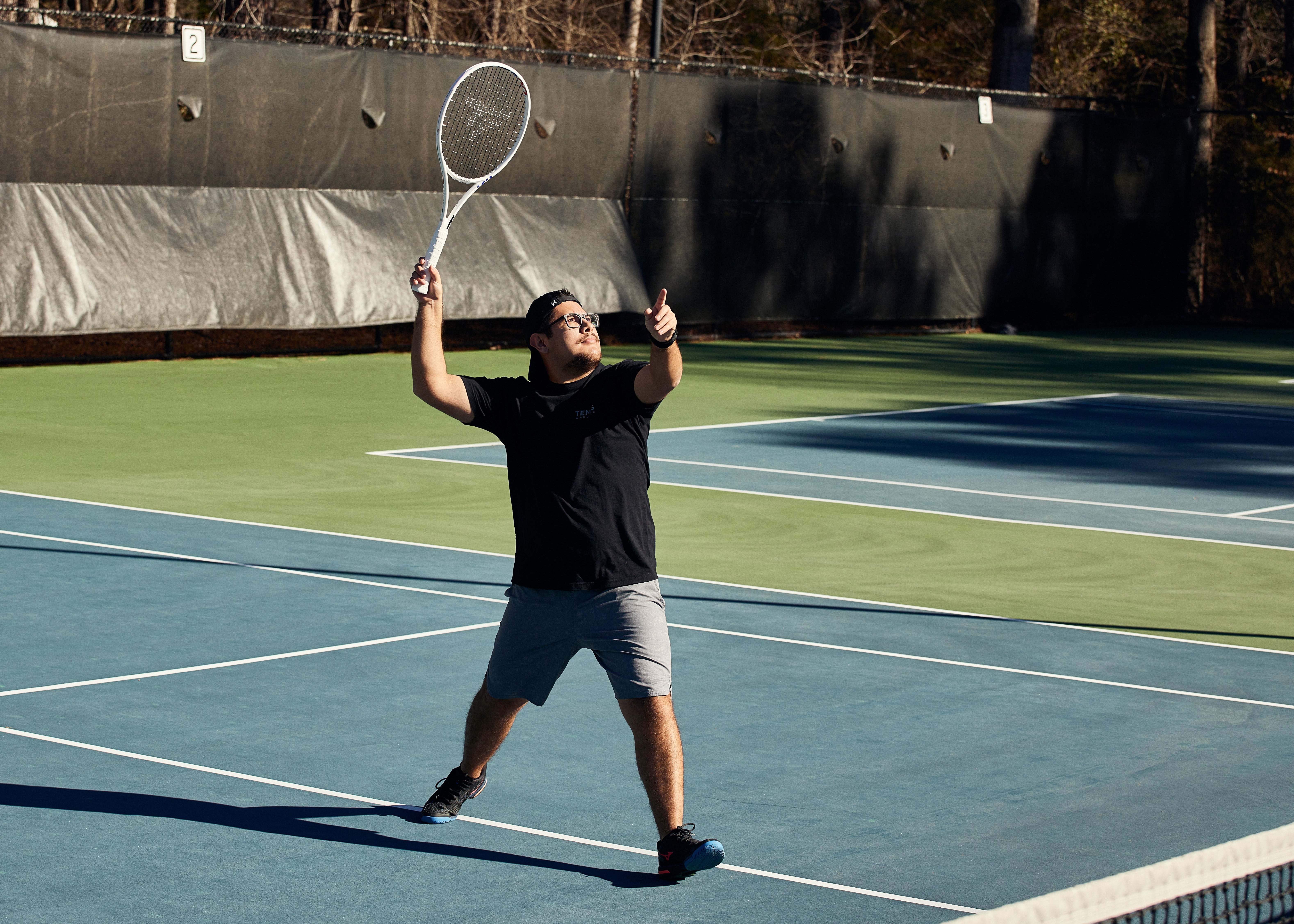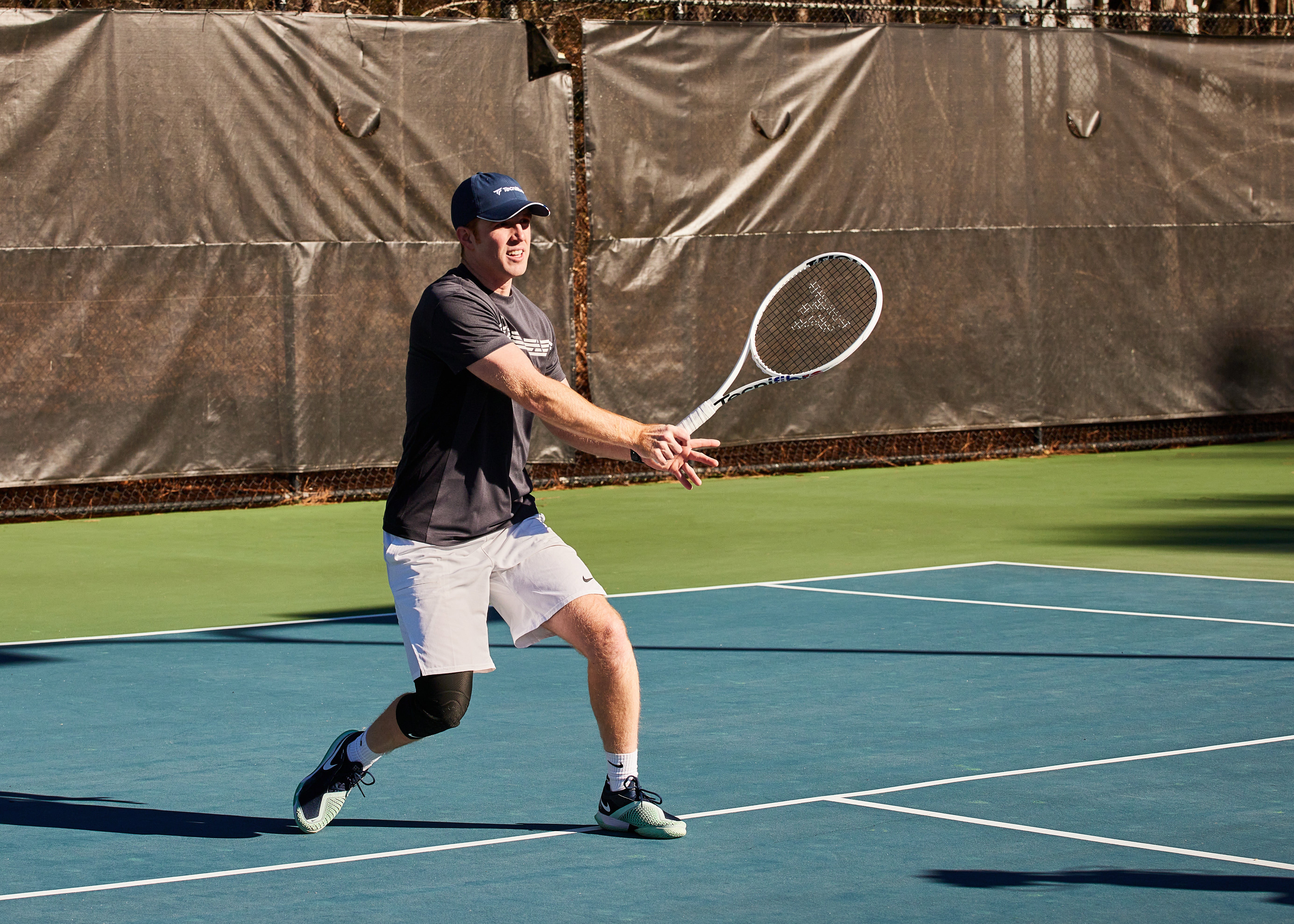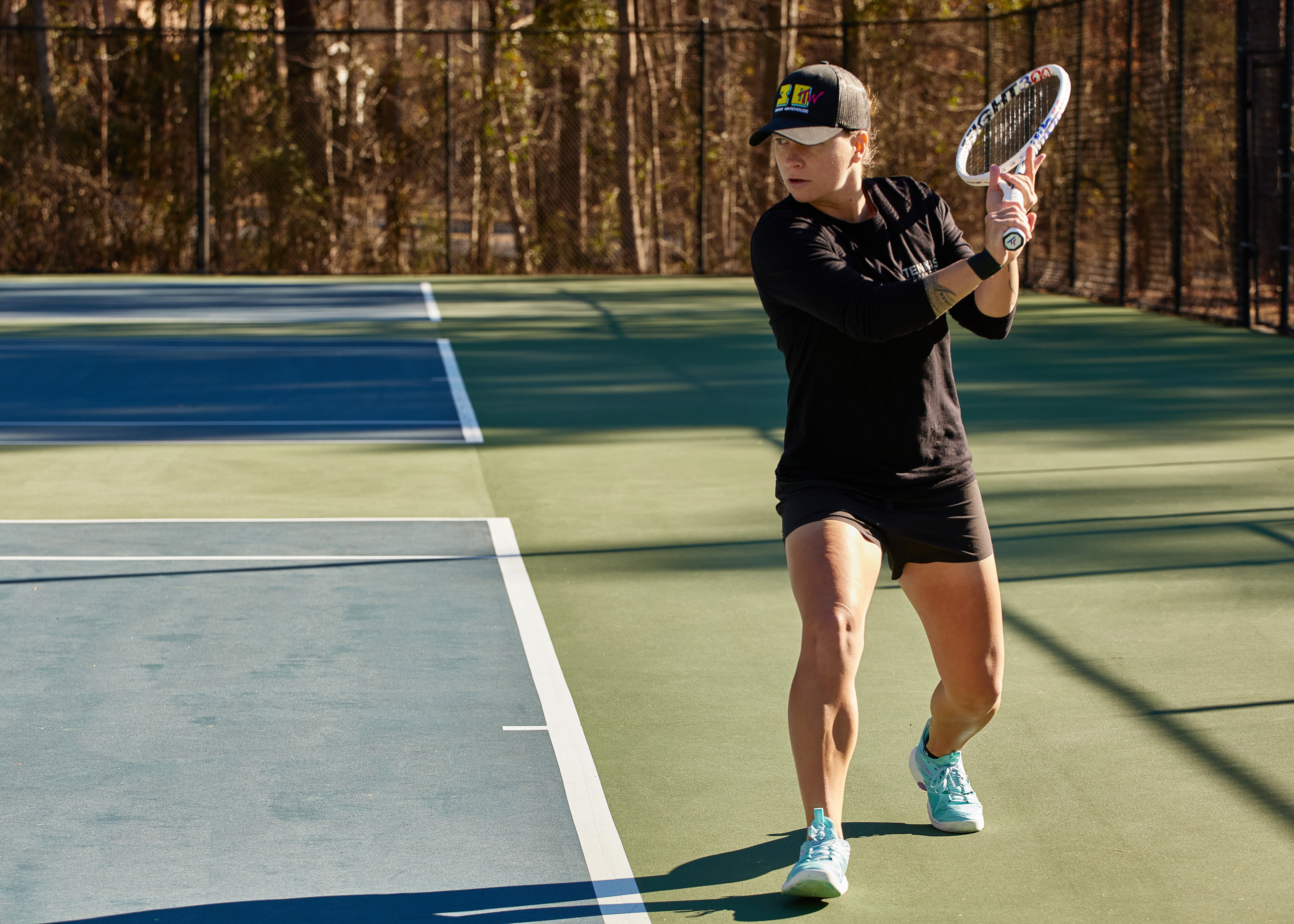Tecnifibre TFight ISO 300 Racquet Review
| Overall | 83 |
|---|---|
| Groundstrokes | 82 |
| Volleys | 82 |
| Serves | 77 |
| Returns | 88 |
| Power | 78 |
| Control | 84 |
| Maneuverability | 81 |
| Stability | 82 |
| Comfort | 81 |
| Touch/Feel | 78 |
| Topspin | 82 |
| Slice | 84 |
Summary
In this generation of the TFight 300, Tecnifibre adds a new ISOFLEX System for a more forgiving and consistent stringbed. Those who have played with the previous version should be content with the speed, spin and control the new TFight 300 ISO produces. The 98-square-inch head size provides control, while the 320 swingweight provides good maneuverability for a quicker reaction time. A 66 RA rounds out the specs and gives the TFight 300 ISO a solid feel on impact. Our playtesters enjoyed the control and stability they found, and they were able to find a groove with the Tecnifibre TFight ISO 300 with little to no adjustment period. Overall, the TFight 300 ISO will appeal to intermediate to advanced players looking for a control-driven frame with great spin potential.
Upsides
- Control
- Stability
- Good blend of power and spin
Downsides
- Lack of plow through
- Launch angle
Ability
- Intermediate to advanced
Groundstrokes - Score: 82
The TFight ISO 300 was an instant hit with our playtesters at the baseline thanks to its balance of power and control. Brittany, who was on the playtest of the preceding TFight 300 RS, compared the two versions, saying, "The previous generation of the TFight 300 surprised me with a higher-than-expected power level from its 98-square-inch head, and I really enjoyed the playtest. I was looking forward to this update, and I was happy to find that the power levels remained the same (but slightly less than the 295). I could be very consistent with my groundstrokes, and I really liked to get a groove on during practice, whether I was hitting cross courts or just down the middle. When I tried to be more aggressive during point play I noticed I didn't have any extra oomph on the ball. I definitely had to make sure I was hitting the approach shot deep and placing it well, otherwise I could expect a very difficult passing shot. Another thing I noticed was that if I wasn't careful my shots would land shorter than expected, which I believe came from a lower launch angle. I was able to hit slices defensively when I needed to, and they stayed low enough to keep me in the point."
Zsofi noted the stability of the TFight 300 ISO and the good power it provided. She said, "The TFight ISO 300 felt very stable on the baseline, and it didn't really get pushed around at all. I didn't feel like I had a crazy amount of power, so it wasn't a standout feature, but I wouldn't say I was lacking it either. I do enjoy hitting heavy balls and going all out with my shots, and because the racquet wasn't overly powerful, I was able to go for those shots. I didn't feel like the racquet head speed was as fast as my racquet of choice, the Tecnifibre TF40 305 16x19, but it wasn't too far off from what I was hoping for."
The TFight ISO 300's blend of control and maneuverability stood out to Austin. He explained, "Having the same mold as the TFight 315, the TFight ISO 300 has many of the aspects I was already familiar with in a lighter package. As seems to be the case across many of the brand's racquets, the launch angle for this TFight 300 was not quite as flighty as you might find from other 16x19 stringbeds. The typical Tecnifibre stability was also apparent, and it made me feel very connected to my groundstrokes from both wings. The static and swingweight are lighter than the 315, and that allowed for slightly more maneuverability and faster racquet head speed. This made the racquet feel relatively powerful, but not to the degree that I would classify it as a power frame."
Howard also highlighted the maneuverability and stability he found at the baseline. He said, "My groundstrokes were solid with this frame. I felt super comfortable on my forehand and my backhand. I was able to generate enough topspin to help move the ball around and to open angles on the court. I normally struggle with getting my racquet into place for my backhand, but the maneuverability made it easy for me to get the TFight 300 ISO into position with plenty of time to spare. Stability was great, and I didn't really find myself having any issues against harder hitting opponents."

Volleys - Score: 82
For the majority of our playtesters on the review, this TFight ISO 300 offered great stability, maneuverability and feel at net. With her all-court game, Zsofi doesn't shy away from the net to finish out points. She said, "I really enjoyed the new TFight ISO 300 at the net! It felt super stable and I felt very connected to my shots. I always had a good sense for where my balls were going."
Likewise, Howard really loved hitting volleys with this racquet. He said, "Touch and feel were incredible with the new update. I did find myself hitting shorter volleys, but in a sense, I enjoyed that. I felt super comfortable hitting anything at net, and stability-wise this frame was solid. Although the TFight 300 ISO felt super comfortable at net, I still had a sense of where the ball was making contact with the stringbed."
Brittany could also play with variety at net. She said, "The TFight ISO 300 offered a nice blend of stability and maneuverability up at net. I could get the racquet into position with ease and it never feel like it was getting pushed around on a hard-hit passing shot attempt. This combined with a nice responsive feel to allow me to hit a variety of volleys, including softening my hands for some touch shots."
The TFight 300 ISO got the job done at net for Austin, but he was left wanting a bit more. He explained, "Volleys were generally solid, but not spectacular in any one particular aspect. The construction, firmness and overall maneuverability of this racquet made blocking shots back and maintaining control very routine, and I was able to find a groove pretty easily on volleys. However, because I prefer racquets with a slightly higher static weight and a more head-light balance, I did miss the stability and plow through that make my volleys a little crisper and more rewarding."

Serves - Score: 77
When it came to starting points with the TFight ISO 300, our playtesters enjoyed loading their second serves with spin. Howard described, "I was able to pick up this TFight ISO 300 and get my serves going more easily than I can with most other 98-square-inch racquets. Although I wasn't able to get the amount of power I would like on my flat serve down the T, I still enjoyed serving out wide with a nice kick to it. When I missed my first serve, I had the confidence to just spin the serve in and get the point going. Overall, it's a solid frame to serve with on both the deuce and ad side."
Austin thought the TFight 300 ISO was more effective on groundstrokes than it was on serves. He said, "I generally find that a racquet will either excel as an all-around package from the baseline with groundstrokes as a strength, or it will stand out as more of an offensive weapon that lends itself to heavier serves, rewarding me with returns that I have time to set up for. The TFight ISO 300 seems to fall into the former category. The specs are lighter than my usual racquet, so like on volleys, I wished for more heft when hitting serves. To its credit, though, because of how maneuverable the TFight 300 ISO is, I did think hitting second serves consistently was a strength."
The serve is one area Brittany was looking for more power. She explained, "There was nothing special for me when it came to serving with the TFight ISO 300. One thing that did surprise me was that it felt a little easier to get it up and over my head and generate racquet head speed compared to the TFight ISO 295. I didn't feel like there was anything special pace-wise behind my serves, so I found myself hitting slice serves out wide for most of my first serves. This was effective enough to pull my opponents off the court. On second serves, I found average spin potential, but I did notice my opponents stepping in to attack, so I was starting off points from a defensive position."
Zsofi had similar feedback to the rest of the team, adding, "I would say the TFight 300 ISO did not really stand out to me on my serves. When it came to confidence in my shots, I felt the most connected to the TFight 300 ISO on slice serves, because I had the most control of my placement."

Returns - Score: 88
The Tecnifibre TFight ISO 300 was a star on returns. All of our playtesters enjoyed the stability and control, and they enjoyed being able to lean in and be aggressive with their swings. With her general preference for returning, it's no surprise that Brittany had a good time with this shot. She said, "As with the majority of the racquets I playtest, I preferred to hit returns over serving with the TFight ISO 300. One of the big reasons was that I liked being able to step in, get the racquet around my body and use the pace of the serve to hit my returns. I didn't have any fear of overhitting and used that to my advantage. This allowed me to start off in a neutral to offensive position even against a first serve. My second serve returns were just as successful, and I enjoyed picking targets and really going after my returns."
"Returns were a pleasure to hit with this racquet," Zsofi added. "I loved really leaning into my shots and being able to plow through my returns to open up the court. The TFight 300 ISO felt very solid upon contact, and I could not find any negatives when it comes to returns."
Continuing the praise for the TFight ISO 300 on returns, Howard said, "I enjoyed being able to take huge cuts at balls and have them land deep enough in the court to get my opponents on their heels. Maneuverability was there with this racquet, and I was able to get the frame into position to block back a couple of body serves. My favorite return with this racquet was my backhand slice to sneak into the net."
Austin finished up the review with his favorite shot to hit with the Tecnifibre TFight ISO 300. He described, "I thought returning was a strength of the TFight ISO 300. I could pick and choose what to do with my returns. The 320ish swingweight offered a good balance, staying maneuverable while still giving me the sense I was getting a substantial shot back against heavier serves. The stability and higher stiffness also offered a good sense of connection and feedback."
Overall - Score: 83
| Technical Specifications | ||
|---|---|---|
| Length | 27 in | 69 cm |
| Head Size | 98 sq in | 632 sq cm |
| Weight | 11.2 oz | 318 gm |
| Balance Point | 12.99 in 33 cm | 4 pts Head Light |
| Construction | 22.5mm / 22.5mm / 22.5mm | |
| Composition | Dynacore HD/Graphite | |
| String Pattern | 16 Mains / 19 Crosses | |
| Babolat RDC Ratings | ||
|---|---|---|
| Score | Grade | |
| Flex Rating | 66 | Range: 0-100 |
| Swing Weight | 320 | Range: 200-400 |
| Brittany's Scores | |||
|---|---|---|---|
| Power | 8.2 | Serves | 8.2 |
| Control | 8.3 | Groundstrokes | 8.2 |
| Maneuverability | 8.4 | Returns | 8.5 |
| Stability | 8.2 | Slice | 8 |
| Comfort | 8.2 | Topspin | 8.4 |
| Touch/Feel | 8.1 | Volleys | 8.4 |
| Overall | 8.2 | ||
| Zsofi's Scores | |||
|---|---|---|---|
| Power | 7.8 | Serves | 8.2 |
| Control | 8.5 | Groundstrokes | 8 |
| Maneuverability | 8 | Returns | 9 |
| Stability | 8.5 | Slice | 9.5 |
| Comfort | 8.5 | Topspin | 8 |
| Touch/Feel | 8.1 | Volleys | 8.5 |
| Overall | 8.5 | ||
| Austin's Scores | |||
|---|---|---|---|
| Power | 7 | Serves | 6.5 |
| Control | 8.5 | Groundstrokes | 8.5 |
| Maneuverability | 7.5 | Returns | 9 |
| Stability | 8 | Slice | 8.25 |
| Comfort | 7.5 | Topspin | 8 |
| Touch/Feel | 7 | Volleys | 7.5 |
| Overall | 8 | ||
| Howard's Scores | |||
|---|---|---|---|
| Power | 8 | Serves | 8 |
| Control | 8.2 | Groundstrokes | 8.2 |
| Maneuverability | 8.5 | Returns | 8.5 |
| Stability | 8 | Slice | 8 |
| Comfort | 8.3 | Topspin | 8.4 |
| Touch/Feel | 8 | Volleys | 8.4 |
| Overall | 8.3 | ||
Playtester Profiles
Brittany: Open level player with a semi-western forehand and a two-handed backhand. She currently plays with the Yonex EZONE 100.
Zsofi: Open level all court player with a semi-western forehand and a one-handed backhand. She currently plays with a Tecnifibre TF40 305 16x19.
Howard: 4.0 all court player with a semi-western forehand and two-handed backhand. Currently using a Prince Tour Diablo MP.
Austin: 5.0 level player with an eastern/semi-western forehand and a one-handed backhand. He currently plays with the Wilson Pro Staff RF97 Autograph v11.

Likes
Brittany - "The Tecnifibre TFight ISO 300 does everything well, although nothing stands out."
Zsofi - "Slices are the absolute highlight! Volleys and the overall stability of the frame too."
Austin - "Hoop stability, control and baseline power."
Howard - "Control, predictability and stability."
Dislikes
Brittany - "Two small dislikes: There's a lower launch angle than I am used to, and I'm looking for easier power on my serves and groundstrokes."
Zsofi - "I would prefer a bit more power and spin, but it's not a big deal since the TFight ISO 300 performs really well overall."
Austin - "I prefer heavier racquets that offer more plow through and have a more head-light balance."
Howard - "I don't love the ping sound when strung up with a full bed of poly without a vibration dampener."
Comparing the racquet to others they've tried, our testers said:
Brittany - "I was able to playtest the TFight ISO 300 and 295 side by side. While the racquets play very similarly overall, there are some subtle differences. The 300 offers a little more control and a precise response. Between the two, though, I prefer the TFight ISO 295. A couple of other racquets that play similarly are the Babolat Pure Drive VS and the Head Radical MP."
Zsofi - "My racquet of choice is the Tecnifibre TF40 305 16x19, so I naturally compared this TFight ISO 300 to that one during this playtest. I prefer the spin and power levels of the TF40 a bit more, otherwise they felt very similar."
Austin - "I haven't hit any prior generations of the TFight 300, but I have hit a few of the 315, including this current generation. Given my preferences, I think the 315 is the better option for me and offers a little bit more to an attacking game style. I do think the 300 is a very solid all-around racquet that doesn't really do anything poorly, so it could fit a lot of people's games."
Howard - "I enjoyed everything this Tecnifibre TFight ISO 300 had to offer, and my biggest issue was the 'ping' sound off the stringbed. I am looking forward to stringing this racquet up at different tensions to see if I can solve that issue. Right now, this TFight ISO 300 is in my top five 98-square-inch racquets of 2023."